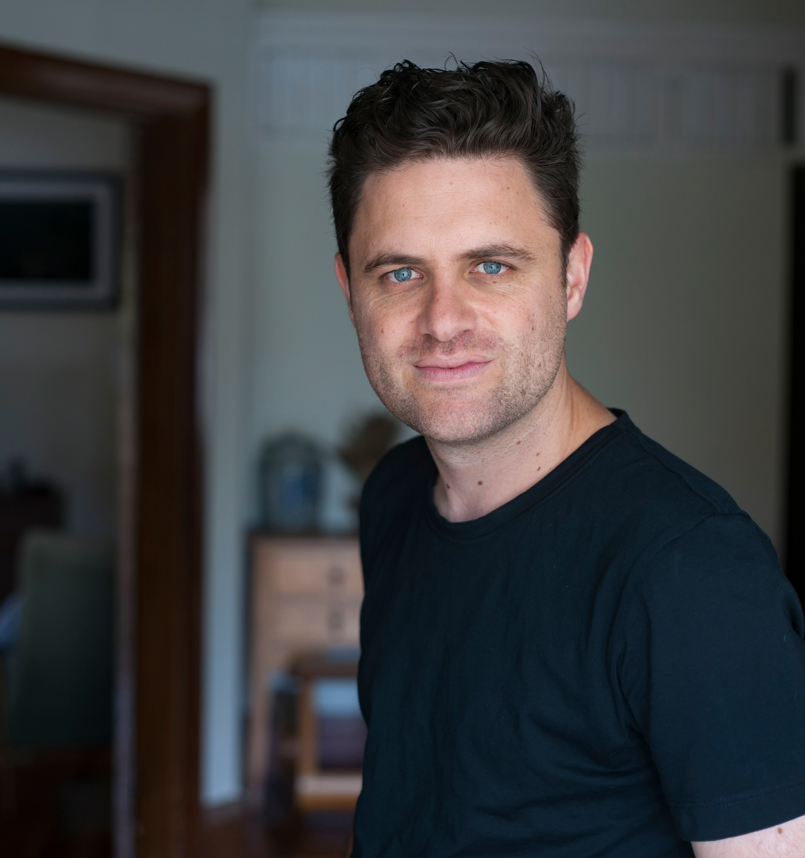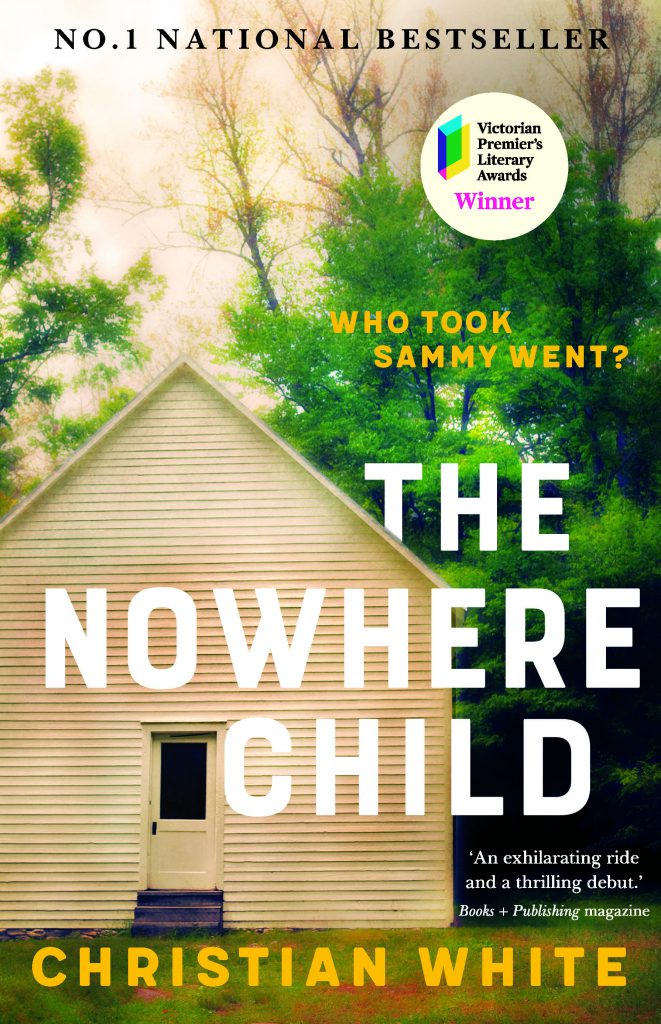Christian White

Between the Lines interviews a diverse selection of Australian writers to uncover the hidden processes, research, and inspiration that goes into the making of a book.
Christian White is an Australian author and screenwriter whose debut novel, The Nowhere Child, became an instant bestseller when it was published in 2018. An early draft of this novel won the 2017 Victorian Premier’s Literary Award for an Unpublished Manuscript, and rights were quickly sold into seventeen countries. He also co-wrote Relic, a psychological horror feature film currently in production, to be produced by Carver Films (The Snowtown Murders, Partisan).
Born and raised on the Mornington Peninsula, Christian had an eclectic range of ‘day jobs’ before he was able to write full time, including food-cart driver on a golf course and video editor for an adult film company. He now spends his days writing from home in Ocean Grove, where he lives with his wife, filmmaker Summer DeRoche, and their adopted greyhound, Issy.
The Nowhere Child – Synopsis
‘Her name is Sammy Went. This photo was taken on her second birthday. Three days later she was gone.’
On a break between teaching photography classes in Melbourne, Kim Leamy is approached by a stranger investigating the disappearance of a little girl from her Kentucky home twenty-eight years earlier. He believes Kim is that girl.
At first she brushes it off, but when Kim scratches the surface of her family history in Australia, questions arise that aren’t easily answered. To find the truth, she must travel to Sammy’s home of Manson, Kentucky, and into a dark past. As the mystery of Sammy’s disappearance unravels and the town’s secrets are revealed, this superb novel builds towards an electrifying climax.
Inspired by Gillian Flynn’s frenetic suspense and Stephen King’s masterful world-building, The Nowhere Child is a combustible tale of trauma, cult, conspiracy and memory. It is the remarkable debut of Christian White, an exhilarating new Australian talent.

You have written a blistering debut novel. I realised I subconsciously avoid all crime related texts, but I’m thoroughly pleased that I read yours. Where did the premise of The Nowhere Child emerge from?
Thank you!
The premise came from a strange place. A few years before writing The Nowhere Child, I was sitting down for Christmas lunch with my nan, who is in her 90s and suffers from dementia. I was having one of those heart-breaking conversations with her, where I explained, ‘I’m Christian, I’m your grandson, that’s Keera, your daughter,’ and so on. To be honest, I did mess with her a little bit, because when I pointed to my brother Jamie I said, ‘I have no idea who that guy is—who invited him?’ But it got me thinking: how does memory work? My nan has lucid moments, so does that mean her memories are still intact and thumping around her head, but she’s just lost the ability to reach them?
Soon after that I started to wonder if there were any memories thumping around my head and if so, how might they change who I was? Then, probably because I read too much true crime, I quickly wondered: what if my parents weren’t my parents, what if they were actually my kidnappers?
That’s very interesting, because you explore memory strikingly and describe it vividly in the novel. In fact, in the afterword, you explain that visiting Mammoth Cave in Kentucky as an adolescent with your family inspired how you wrote about your protagonist’s memory. Were there other lingering experiences in your life that made their way into The Nowhere Child?
Absolutely. Personally, I find it difficult to avoid those lingering experiences. So much of storytelling is about lowering a bucket into some deep, dark well inside yourself and sorting through what comes up. That well, I believe, is directly connected to your subconscious, where all sorts of memories, life experiences, anxieties, fears and loves are swirling around, so it’s impossible not to get it all mixed up.
Half the book is set in the 90s (the decade where I ‘came of age’) so I used a lot of my teenage memories to sort of flavour the atmosphere of Kentucky in the 90s, but there are also loads of similarities between my characters and people in my real life. For example, my wife’s grandfather was killed in a military exercise. Travis Eckles, a character from the book, lost his father the same way. I also know someone who watched their parents’ marriage fall apart because one of them found God and the other didn’t, which created a fascinating tension within the family. I took all of that and gave it directly to the central family in The Nowhere Child.

We should thank the people in your life that contributed to your ‘well’, because the myriad of characters in the novel feel fully fleshed out because of that. Was it something from your well that inspired Manson, the primary setting of your novel? I grew up in a rural town here in Western Australia, and the best I can manage when someone asks me what it was like is “interesting,” or perhaps “colourful,” and Manson resonated with me in a way I wasn’t expecting.
I’m so glad to hear Manson resonated with you. I grew up in a small suburb on the Mornington Peninsula. It was beautiful, but it was also insular and bizarre in ways that all small towns are, so I took a lot of inspiration from home. In fact, most of the street names in the book are taken directly from my neighbourhood. The town didn’t wholly form in my mind though, until I gave it a name. It’s a bit of a cheat, really, but naming a place after a famous cult leader made it feel instantly unsettling.
It did! I remember thinking of Charles Manson, in fact, especially as the novel escalated and a particular character developed. There were other aspects that were, for me, instantly unsettling too. I found The Church of the Light Within a particularly striking facet of Manson in that manner, where did you pull this religious fundamentalism from?
While the Church of the Light Within is fictional, it’s heavily based on a number of serpent handling churches in the southern states of America. I’ve been fascinated with Pentecostal snake handling for years and would spend hours reading about them and watching services online. Back then, that was called procrastination, but now I can call it research! I actually toned down some of the more bizarre and extreme real-life practices for the book because I didn’t want it to seem too unbelievable. Even still, I recently had an email from a reader claiming the snake parts of the book were too far-fetched. I replied with a few helpful links that will likely keep her up all night!
That’s so interesting. I didn’t find the snake handling aspect of the Church unbelievable at all but then, since I was raised in the Catholic Church, the faith of fundamentalists never surprises me. It seems that each of the characters in the novel are touched by the Light Within—a side effect of being in a small town, perhaps; was it difficult writing a variety of subject positions in relation to this?
It was difficult at first, because I wanted the Church to have touched each character in some large or small way, but as soon as I started thinking about what faith might mean for certain characters, it helped shape who they became. I was raised agnostic, but I’ve always been interested in the way people’s faith can shape who they are—when someone leans toward God and when they lean away from God.
As someone who has leaned in and out of the Catholic church at various points in my life, I can certainly attest to that. For me, arresting my religious upbringing has been a process of time, which parallels the experience of a few of your characters. But time in your novel is split between ‘Then’ and ‘Now’. Between Sammy Went as a child, and her kidnapping, and Kim Leamy as an adult, trying to unravel a cacophony of lies. What was your writing process for this?
Early on I tried to write the ‘Then’ and ‘Now’ sections separately, but it quickly became necessary to write them in sequence, because certain plot points and reveals needed to happen at certain times to have it all make sense and feel compelling. Martin Hughes, from Affirm Press, a man with many strange metaphors, described each chapter as a vine, and the reader as an orangutan swinging from one to the next. Each vine needed to be strong enough to support the weight of the orangutan and help propel it to the next.
My favourite part about having a thirty-year gap between timelines is you get to meet someone in 1990, then in modern day, and they’ve changed in ways that are hopefully surprising, and the reader gets to imagine what happened between then and now.
That was a wonderful aspect of the novel, and the development of characters across those thirty years was always surprising and elicited a variety of emotions—which attests to your writing abilities. On this, you’ve remarked that Stephen King has influenced you significantly. What is it about King, specifically, and are there other notable authors who have shaped you as a writer?
I think every book I read (good or bad) shapes me as a writer in some way, but Stephen King is certainly the most inspiring. First, he’s a genius and has created (and continues to create) worlds and stories that are vast and dark and interesting and so easy to escape into. Second, in his book On Writing, he lays out everything you need to write a novel. I followed his advice and The Nowhere Child was the result. This book sits in the crime, mystery, thriller genre, so authors like Gillian Flynn, Alex Garland, Thomas Harris, A.J. Finn and Jane Harper played a huge part. But writers in other genres greatly inspire me too, like Kurt Vonnegut, George R.R. Martin and Haruki Murakami.
Given all the buzz surrounding your debut novel, you might find yourself sitting shoulder to shoulder with the likes of King! And, of course, you won the Victorian Premier’s Literary Award for an Unpublished Manuscript—which lead to the publication of The Nowhere Child—but you commented that you assumed you would lose! Were you blindsided by anything during the publication of your book, and what points of advice would you offer other writers struggling to believe in themselves and their writing?
I live by the motto, ‘hope for the best, expect the worst, and be happy with what you get’, so I think I felt blindsided by how supported I was during this process, by my publishers, booksellers, and most of all, the readers. Very early on in this process I realised the publishing world is full of book people, so there’s no need to feel nervous or anxious or competitive. These are my people. For someone like me, who’s spent much of their life searching for their place in the world, it felt a bit like coming home.
The best piece of writing advice I can give is: just click send. If you’re thinking about sending your manuscript to a publisher, agent or writing competition, just do it. If you wait for it to be perfect, that will likely never happen. It really sucks being rejected, but the reward far outweighs the risk. And don’t forget: publishers, agents and writing competitions want what you have—a good story.
You can purchase The Nowhere Child from Affirm Press.
Jay Anderson is a professional writer and editor, with a background in Literary and Cultural Studies. He’s currently completing an Honours of creative writing at Curtin University—where he is the Chief Editor of the campus’ student publication, Grok Magazine.
This interview was originally published on 10 April 2019.